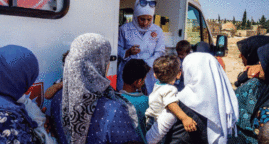Syria: Describing the toll of war on health in absentia
This article was published first in the New Zealand Medical Journal under the title “In Absentia: describing the toll of war on health in Syria”.
In our line of work, we rely on numbers. The number of patients treated in clinics; the number of children with pneumonia, diarrhoea or severe malnutrition; the number of patients admitted to a hospital; the number of patients undergoing emergency surgery; the number of babies born; the number of children vaccinated, and the number of people counselled.
The numbers guide us to where the needs are. They tell us what is making people sick. They indicate how difficult it is for some to access healthcare. They tell us when and where people die. They paint a picture from which we can describe, interpret and then plan the best way to respond to a population’s health needs.
We can adjust medical interventions in order to treat more people, to reduce disease burden and avert death. The central tenant is to provide healthcare, alleviate suffering and provide comfort to people. Not just those patients directly in front of us, but everyone around them. Numbers are important: without them we cannot effectively do our job.
In war-torn Syria, patients are besieged and in inaccessible areas. True numbers are unknown but those we do see paint a picture so bleak that the size and scale of an emergency health response seem unimaginable.
For six long years, war has waged across Syria, resulting in an unprecedented 4.8 million people becoming refugees[1]. The responsibility to care for this refugee population falls largely to Syria’s neighbours[2].
Inside Syria, the United Nations High Commission for Refugees has some overwhelming numbers. It reports that 13.5 million people are in direct need of medical and humanitarian assistance. More than six million have been forced from their homes and are now internally displaced due to shifting battle lines, armed groups and militia. Some 4.3 million people are categorised as ‘’hard to reach’’ – a humanitarian euphemism used when obtaining information from communities is limited and, as a result, the likelihood of the population accessing sufficient protection, food, shelter, water or healthcare is extremely low.
The effects of war are not limited to frontlines or battle grounds. Indiscriminate bombings of civilians, hospitals and cities cause catastrophic blast injuries, permanent disabilities and deaths. War has insidiously crept into every consultation room, every hospital bed, health post and clinic in areas indirectly affected by the Syrian crisis over the last six years.
Médecins Sans Frontières (MSF) has tried to maintain operations throughout the country over the course of the conflict.
Despite repeated requests for access to work in government-held areas, we have not been able to secure authorisation to do so. We can therefore only provide direct assistance and deploy teams in opposition-held territories and can mainly speak of what we see in those locations.
These medical programmes are not classic by our definition. They have been forced to start and stop as fighting draws near. They have been relocated after hospitals have been damaged by shells and mortar, or when the populations are forcibly displaced.
These projects and hospitals operate all the time under impossible conditions with new staff, new systems and rapidly changing security management. Unpredictable border controls change from week to week, resulting in dramatic fluctuations in the availability of medicines and supplies. It is no easy feat to provide meaningful healthcare care in such an environment.
What we can describe from the numbers and experience generated from these programmes is indicative of a grave medical situation and looming public health crisis.
At the most practical level, there are not enough doctors, nurses or midwives in northern Syria. Most have fled, many have been killed, and the studies of future health workers have long been disrupted. There are not enough functioning health facilities at primary, secondary or tertiary level. There are also not enough medical supplies making their way across the international borders.
With regard to the population’s health, we see gains in child health outcomes demonstrated in pre-war Syria slowly slipping away. Vaccination rates are at an all-time low – MSF’s survey of children in northern Syria reveals that only 17 per cent had received their complete childhood immunisation schedule by the time they reached the age of five.
We know that Syrian children still do not receive the pneumococcal vaccine, which would considerably reduce the incidence of paediatric pneumococcal pneumonia infections – a vital prevention strategy in conflict settings where access to antibiotics, clinics and hospital care is fraught.
We have witnessed multiple and recurrent outbreaks of polio, measles and typhoid plaguing children across the country, causing severe illness and contributing to entirely preventable deaths. We have seen children born through the course of the conflict with congenital abnormalities or common paediatric problems die or remain uncared for because the services and specialised care they need no longer exists or is inaccessible to them.
Women’s access to functioning reproductive health care services is too low. It is so low that hardly any women are having routine antenatal care. Women in labour are forced to deliver at home as the birthing services no longer exist.
There is evidence that the few functioning facilities offering emergency obstetric surgery have seen a significant surge in the number of women electing to have unindicated caesarean sections, at great financial cost and unnecessary risk, rather than accept the risk of delivering at home.
All around is evidence of worsening malnutrition among infants, as formula milk costs exceed what families can afford and infant feeding practices are poor due to lack of support and education programmes.
The absence of health facilities means that people living with chronic diseases such as diabetes, heart disease, renal disease, thalassemia, epilepsy and asthma report experiencing unabated symptoms. These patients’ long-term disease progression, life expectancy and the catastrophic burden on the future health system are yet to be seen.
Many people are suffering from the psychological effects of trauma, grief, loss, depression and anxiety and have very few places to seek care. Many mothers tell us their children are angry or withdrawn, or have resumed bed wetting. Husbands and wives fight more than before. Hope is diminished, and people remain uncertain and fearful of the future.
For six years, the war has robbed the Syrian people of their right to healthcare. Poor politics and failed diplomacy have enabled the war to continue remorselessly and kept borders closed, taking away the rights of the Syrian people to flee the horrors and preventing medical humanitarian organisations like MSF from accessing and supporting those most in need.
MSF doesn’t have all the numbers. We just see those suffering and dying in front of our eyes. Many more individuals and families will continue to suffer unless this war stops. One more life is too many: collectively we need to do more, not only to stop the war but to help those who are suffering.
Related Articles
The Migrant Boon
04/07/2017. New research from the McKinsey Global Institute (MGI) shows that cross-border migrants contribute nearly 10% of global GDP.
Implementing a national strategy for the integration of Roma people in Hungary
04/07/2019. Miklos Vecsei C.G.M. vice-President of the Hungarian Charity Service of the Order, was recently appointed State Commissioner charged with coordinating the drafting and implementation of a diagnosis-based national strategy for the integration of Roma people.
Order of Malta in Hungary scaling up its assistance work to help Syrian population
12/27/2018. After nearly 8 years of war in Syria, the Order of Malta is still present in the region helping the local population with medical and humanitarian activities.





